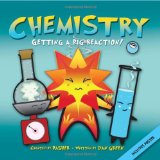Do you know a child who is interested in science but finds the traditional nonfiction books a bit too tame and lame? Looking for something a little edgy with a bite of humor (“You have to keep your ‘Ion’ this bunch…”)? Then you might want to take a look at the Basher series science books. 
Chemistry: Getting a Big Reaction! by Dan Green and Simon Basher is not written like a textbook. It is organized more like a reference book, such as a dictionary or an encyclopedia. The different terms/concepts are developed as characters. The sections are written in the first person from that character’s point of view, and each section stands on its own. For example, Acid says, “I’m mad, I’m bad, and thoroughly dangerous to know. Given a chance I’ll eat away Metal and burn through your skin.” (In case you wondered, all characters’ names are capitalized.)
As with Punctuation: The Write Stuff, each character has an accompanying illustration to show what it would look like. The illustrations appear to have roots in Japanese chibi; they are cute and brightly colored, such as the bright orange character in the center of the cover, which represents “Combustion.” These images really help visual learners remember details about what the terms mean. The symbolism of the illustrations works more clearly for some concepts than others, probably because of the complex nature of the topic.
I like that Green chose to include organic materials like esters, found in ingredient lists on labels of common products. The section on “Smart Materials” is fascinating. It inspired me to look up more and write a blog article about them.
The overall organization of material, however, is not as strong as it could be. Why did Green add a discussion of the elements carbon and nitrogen at the very end of the book, after a discussion of complex molecules like proteins that are made up of those elements? He also talked about enzymes, which are basically proteins, well before defining and discussing proteins.
Organizational flaws aside, this book would be useful for the child that needs to brush up on chemistry terminology or who has struggled with chemistry presented in a more traditional way. The concepts are really shaken up and given a lively new twist, which makes them fresh and interesting.
Reading level: Ages 9-12
Paperback: 128 pages
Publisher: Kingfisher (July 6, 2010)
ISBN-10: 0753464136
ISBN-13: 978-0753464137
Basher Science: Chemistry: Getting a Big Reaction
In this video, you can see some of the other books offered in this series.
Nonfiction Monday is a blogging celebration of nonfiction books for kids. For more information, stop by Anastasia Suen’s Nonfiction Monday blog. This week’s post is at Playing By The Book.
This book was provided for review.





